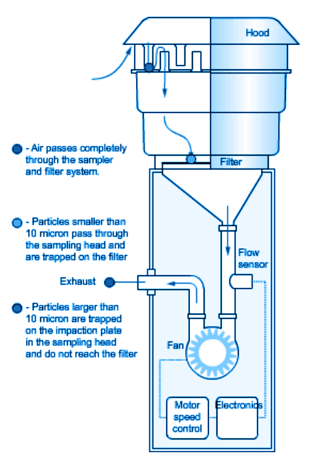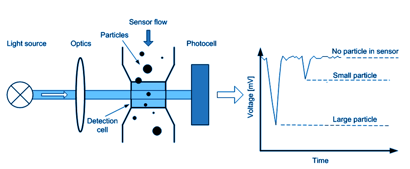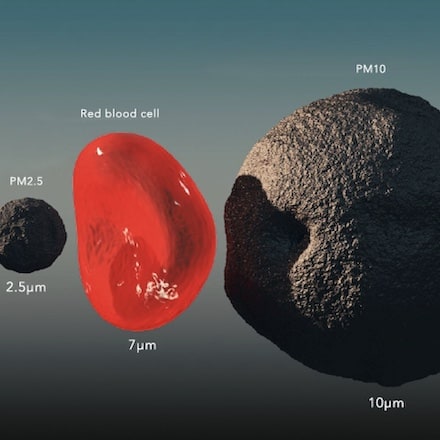Air Quality Monitoring: Get to know All about Ambient Air Quality Monitoring
It is estimated that 7 million deaths occur due to polluted air. Prolonged exposure to poor quality of air can lead to chronic respiratory diseases. Air pollution blocks sunlight causing acid rain, hence keeping air affecting forests, crops, wildlife, and the environment as a whole, and hence keeping air quality in check becomes essential to human health and the environment. Know all about Air Quality Monitoring in the article.
Table of Contents:
- What is ambient air quality? - The Actual Meaning of Ambient Air?
- What is Air Quality Monitoring?
- What is the Air Quality Index?
- Why do we need Air Quality Monitoring?
- Indoor air quality monitoring and Outdoor Air Quality Monitoring
- Methods of Monitoring Air Quality- How is Air Quality Measured?
- What are AAQMs and CAAQMs?
- Legal Ambient Air Quality Standards
- What is the need to achieve prescribed levels of PM Concentration?
- Where to Install Air Quality Monitors?
- Conclusion
- References
What are ambient air and ambient air quality?
The ambient air is the air in its natural state outside and often inside certain premises. It comprises 78% nitrogen, and 21% oxygen and the other 1% is a combination of carbon, helium, methane, argon, and hydrogen. The closer the air is to sea level, the higher the percentage of oxygen.
Human activities such as manufacturing processes and the burning of fossil fuels from several industries and factories impact this atmospheric air directly causing Ambient Air Pollution. The ambient air quality is determined when the pollutants in the atmosphere are measured at the ground level, away from the source of pollution through air quality monitors.
International and national ambient air quality standards are laid by different organizations that define the concentration of pollutants in the air to promote a better and healthy way of living for human beings, and animals, and also for the welfare of the environment. These ambient air quality standards from different organizations such as CPCB Central Pollution Control Board, the United States Environmental Protection Agency(US EPA), and World Health Organization(WHO) may differ from each other. Ambient air quality is also called Outdoor Air Quality.
What is Air Quality Monitoring?
Air quality monitoring is a long-term systematic process of analyzing pollutant levels by measuring the types and quality of pollutants present in the surroundings. It is essential for air quality control and management, indoors and outdoors. This process of air quality inspection is used for analyzing the pollutants in the air and determining the trends of improvement or deterioration in the air quality. There are two types of air quality monitoring: Ambient air quality monitoring and Emissions monitoring.
What is the Air Quality Index (AQI)?
Air Quality Index or AQI refers to an index for reporting the quality of air regularly. It helps people know their local air quality and understand its effect on one’s health. This index is depicted like a scale, the higher the values on the scale, the greater the health concern. The AQI consists of the data of 5 major pollutants called: particulate pollutants: PM10 and PM2.5, ground-level ozone, carbon monoxide, sulfur dioxide, and nitrogen dioxide. The Air Quality Index is divided into 6 levels depicting different levels of health concerns. To make it more simple for the general public to understand, the different levels in the AQI table are represented with a certain color.
An air quality index serves the following objectives:
- It identifies faulty practices within institutions and helps implement robust monitoring systems to measure the set target for pollution reduction and achieve clean air.
- Helps monitor improvement, degradation, or any change in air quality.
- Informs people about environmental conditions and is helpful for people suffering from diseases caused by air pollution.
- It helps people compare air conditions from different locations.
Why do we need Air Quality Monitoring?
Monitoring pollutant concentrations serves as the basis of pollution abatement strategies. The primary purpose of monitoring is to determine essential insights and relevant information that helps us define the pollution problem to solve it. Air quality monitors also enable us to track the progress of mitigation strategies by assessing the efficacy and efficiency of policy intervention. With such data, we can fine-tune our response to reduce exposure to harmful pollutants in our surroundings.
The principal factors governing air pollution are, the location of the source of emission (indoor and outdoor), topography, and meteorological conditions. Due to region-specific factors and varied climatic conditions, the distribution and extent of pollution is different everywhere.
According to the US EPA, it is imperative to monitor the pollution problem of the region of interest to reduce the concentration levels. Following are the reasons why we need to monitor ambient air quality:
- Provide air pollution data to the general public promptly;
- Support implementation of air quality goals or standards;
- Evaluate the effectiveness of emissions control strategies;
- Provide information on air quality trends;
- Enables us to carry out long-term trend analysis.
- Support research (e.g., long-term studies of the health effects of air pollution).
Indoor air quality monitoring Vs Outdoor Air Quality Monitoring:
Indoor air quality commonly known as IAQ refers to the air quality within and around buildings and structures, especially as it relates to the health and comfort of building occupants. Understanding and controlling common pollutants indoors can help reduce your risk of illnesses caused due exposure to poor indoor air quality.
The air in indoor spaces is as polluted as, if not more than, outdoor air. The components of indoor air are particles such as dust mites, pollens, carbon fibers, pet dander, etc., and odors such as VOCs (Volatile Organic Compounds) from paints and varnishes, smoke, cooking odors, etc. We overlook the rudimentary inclusions at home that contribute the most to polluting indoor air quality. The effects of indoor air pollution are so severe that they impact our productivity at work, children tend to feel lethargic within a period after being exposed to polluted air for a long time, which may lead to absenteeism, and a greater impact on education can be observed perhaps.
Whereas, Outdoor air quality monitoring or Ambient air quality refers to the air quality outside and often inside certain premises and is referred to as ambient air quality. Ambient air quality standards are laid by different organizations that define the concentration of pollutants in the air to promote a better and healthy way of living for human beings, and animals and also for the welfare of the environment.
Ambient air pollution is driven by industrialization, uncontrolled urbanization, population growth, fossil fuel combustion, and an absence of adequate national or international chemical policy. Ambient air pollution levels are on a constant rise with around 66% of increment over the past two decades. Policies like the Green Belt can be very effective in naturally improving air quality. Green belt safeguards the vital resources that clean our air by capturing particulate matter and gradually enhancing the quality of air.
Methods of Monitoring Air Quality - How is Air Quality Measured?
So, how to measure air quality? There are different methods adopted for air quality measurement, to identify Ambient Air Pollution including the concentration of PM pollutants. The methods adopted internationally are Gravimetric, Tapered Element Oscillating Microbalance (TEOM), and Laser scattering:
High-volume Gravimetric:

This method to do ambient air monitoring analyzes PM10 pollutants in the ambient air with the help of filtration. For ambient Air testing, it takes in the ambient air samples and typically samples over 1500 cubic meters of air over 24 hours, these samples are large known volumes of air through pre-weighed filters. It collects Total Suspended Particulate Matter (TSP) which may also be used to determine the chemical elements in the air that pose risk to human health.
TEOM:
.png?width=277&name=Tapered%20Element%20Oscillating%20Microbalance%20(TEOM).png)
Tapered Element Oscillating microbalance analyses the concentration of particulate pollutants by passing the air through an exchangeable filter cartridge leading to the deposition of particulates on the filter. The filtered air then passes through the tapered tube to a flow controller. This air monitoring equipment is used to analyze particles less than equal to 10 micrometers in diameter.
Beta Attenuation Monitoring (BAM):
.png?width=331&name=Beta%20Attenuation%20Monitoring%20(BAM).png)
This is the conventional technique for ambient air quality monitoring PM10 and PM2.5 pollutants. This method of outdoor air quality monitoring employs the absorption of beta radiation by solid particles extracted from airflow.
Laser Scattering:

Also known as optical particle counter (OPC), this PM10 monitoring system is based on the physical principle of light scattering. It measures dust particles brightened by the laser light at a right angle. These air quality monitors have no optical signals unless there is dust present. These types of monitors are preferred to monitor PM10 pollutants in ambient air as they yield quicker and more accurate results and are inexpensive.
Even after abiding by the methods and guidelines laid down by the government, the air quality measurement can be affected by various factors such as-
- the characteristics of air exhibited as fluid and gas.
- the standards of accuracy that must be met when making measurements.
- the performance of air quality test instruments.
- the manner scheduled calibrations are carried out.
What are AAQMs and CAAQMs?
Ambient Air Quality Monitoring Systems (AAQMS):
Ambient air quality monitoring systems or generally known as Manual air quality monitoring systems sample ambient air and collect the data for a period of time to then manually transfer the data for analysis. Once the data is analyzed, a report is prepared manually. AAQMS includes a High Volume Sampler System to sample a known volume of air through the use of filters. Depending upon the weight before and after sampling, the filter is analyzed for different pollutants. The process of air sampling, data collection, data analysis, and report preparation takes from 2 to 7 days to provide the proper information about ambient air pollution in a particular location.
Continuous Ambient Air Quality Monitoring Stations (CAAQMS):
Continuous Ambient Air Quality Monitoring Stations use exclusive technology like IoT to collect and transfer data automatically with reduced chances of manual errors. It is an advanced version of AAQMS. The air quality data is collected in real-time and transferred to the servers for analysis and preparation of reports. The interval of transfer of data is adjustable between 2-30 minutes and then the data is analyzed with AI and used accordingly.
CAAQMS works on different principles and analyzers in an automated manner, generating accurate data, and reducing the possibility of manual errors. There are two ways to analyze data for continuous ambient air quality monitoring:
- Sensor-based system: The air monitoring equipment uses a sensor that works on different principles to measure different pollutants, for example, PM sensors work on the principle of Laser Scattering.
- CPCB/SPCB: Regulatory monitoring by Central Pollution Control Board and State Pollution Control Board is conducted to collect the ambient air pollution data from different cities and analyze it at the center. A traditional CAAQMS has dedicated analyzers for different pollutants, for example, PM pollutants are analyzed using gravimetry and filtration. Currently, the national air quality monitoring network is present only in 268 cities, out of the 5,000 cities and towns in India due to high cost, high manpower requirements, and costly O&M procedures.
Legal Ambient Air Quality Standards:
Once one is aware of the pollutants present in the industrial emission, it is essential to monitor emission levels in the plant by deploying Air Quality Monitors. Heavy industries have to abide by certain guidelines laid down by the government associations like the Central Pollution Control Board (CPCB), United States Environmental Protection Agency(US EPA), and World Health Organization(WHO). Air monitoring equipment helps significantly and demonstrably measure and monitor emissions in heavy industries.
Here are the prescribed PM concentration levels:
PM concentration levels in ambient air prescribed by Central Pollution Control Board (CPCB)
PM concentration levels in ambient air are prescribed by World Health Organization (WHO)
The United States Environmental Protection Agency (US EPA) PM concentration guidelines are 25 μg/m3 in 24 hours duration and for annual monitoring, the prescribed PM concentration levels are 8 μg/m3.
*Annual Arithmetic mean of a minimum of 104 measurements in a year at a particular site taken twice a week 24 hourly at uniform intervals.
** 24 hourly or 8 hourly or 1 hourly monitored values, as applicable, shall be complied with 98% of the time in a year. 2%of the time, they may exceed the limits but not on two consecutive days of monitoring.
What is the need to achieve prescribed levels of PM Concentration?
Particulate air pollution is a global issue. Existing PM10 and PM2.5 monitor networks have shown that PM concentrations have increased manifold worldwide in the past few years. Severe health and economic implications resulted in various international agreements. The Paris Agreement of 2015 is one such critical international agreement. Member Countries agreed on the Sustainable Development Goals and the arrangement of reducing greenhouse gas emissions worldwide. Similarly, in India, the National Air Quality Monitoring Programme (NAMP) identified the limitation of inadequate PM monitoring systems. The National Clean Air Programme (NCAP) aims to attain a 20-30% reduction in PM10 and PM2.5, by 2024. It has also allocated a budget to expand the networks of PM monitors. Along with monitoring pollutants, it addresses the institutional and administrative aspects of air pollution reduction.
Where to Install Air Quality Monitors?
The use of air quality monitoring systems to monitor indoor and ambient air quality has become a widespread practice. One of the primary considerations of installing an air quality monitor is to choose the one right for you as per your requirement. Then comes the positioning or placement of the monitor to capture accurate data on the air quality.
Considerations while installing Air Quality Monitors:
-
Determine the location depending upon the purpose of measurement.
-
Ensure that the monitors are secure from vandalism and theft to ensure safe site operations.
-
Get access to install, visit, and service the air quality monitors.
-
Ensure that the sensors are installed at least 6 feet from the ground level, rooftop, or other objects and away from obstructions, vegetation, or emission sources that would interfere with the measurements.
-
Determine requirements and establish power early.
-
Take photos of air quality monitors installation and site.
-
Ensure reliable communication before installation.
-
Record information about the site including longitude, latitude, elevation, nearby obstacle, date of installation, etc.
Conclusion:
There have not been significant efforts in India to do air quality inspections or decipher solutions to constantly degrading air quality and alarming air quality indexes. Despite the government, guidelines, and policy making in active mode, India is still far from practical execution in the air quality monitoring department. Given having a long race to run, State Pollution Control Boards are taking certain good practices into action. The Ministry of Environment, Forest, and Climate Change is working in collaboration with the state governments under the National Clean Air Programme intending to reduce PM pollution by 20–30% by 2024 in the cities identified with alarming situations, though the emphasis to mitigate ambient air pollution in polluting industrial sector is yet to be witnessed.
Does your plant also surpass the regulatory levels of pollutants?
Talk to our air quality experts now!
References:
https://www.sciencedirect.com/topics/earth-and-planetary-sciences/air-quality-monitoring
https://www.epa.gov/air-quality-management-process/managing-air-quality-ambient-air-monitoring
https://cpcb.nic.in/displaypdf.php?id=bmF0aW9uYWwtYWlyLXF1YWxpdHktaW5kZXgvQWJvdXRfQVFJLnBkZg==
https://sustainenvironres.biomedcentral.com/articles/10.1186/s42834-020-0047-y
https://www.downtoearth.org.in/news/all-about-effective-air-quality-monitoring-46494
https://oizom.com/knowledege-bank/particulate-matter-monitoring-pm10/
https://www.epa.gov/indoor-air-quality-iaq/introduction-indoor-air-quality
https://www.thermofisher.com/us/en/home/industrial/environmental/environmental-learning-center/air-quality-analysis-information/teom-technology-particulate-matter-measurement.html
https://www.epa.gov/air-quality-management-process/managing-air-quality-ambient-air-monitoring
https://www.downtoearth.org.in/news/all-about-effective-air-quality-monitoring-46494

.svg)
.webp?width=1080&height=1080&name=Free%20Case%20Study%20Steel%20Plant%20(1).webp)







Post Comments